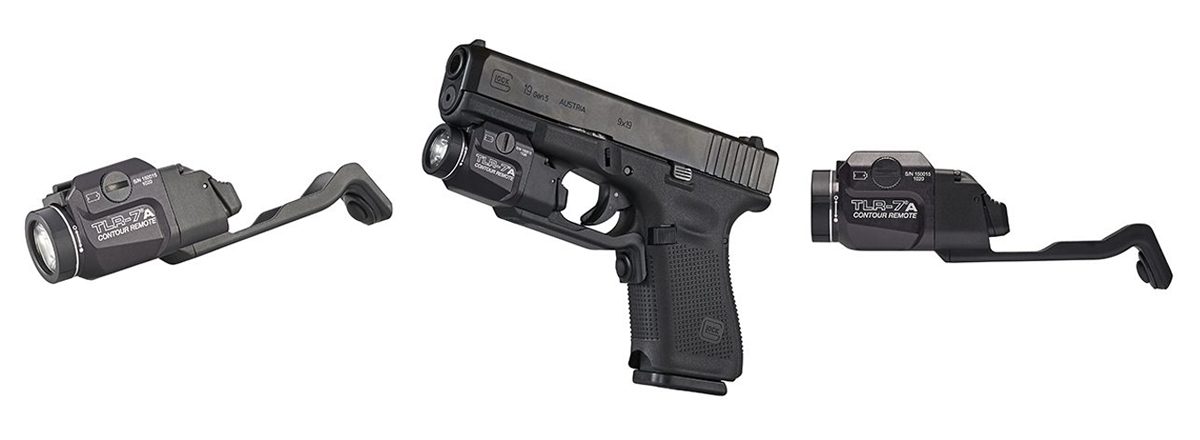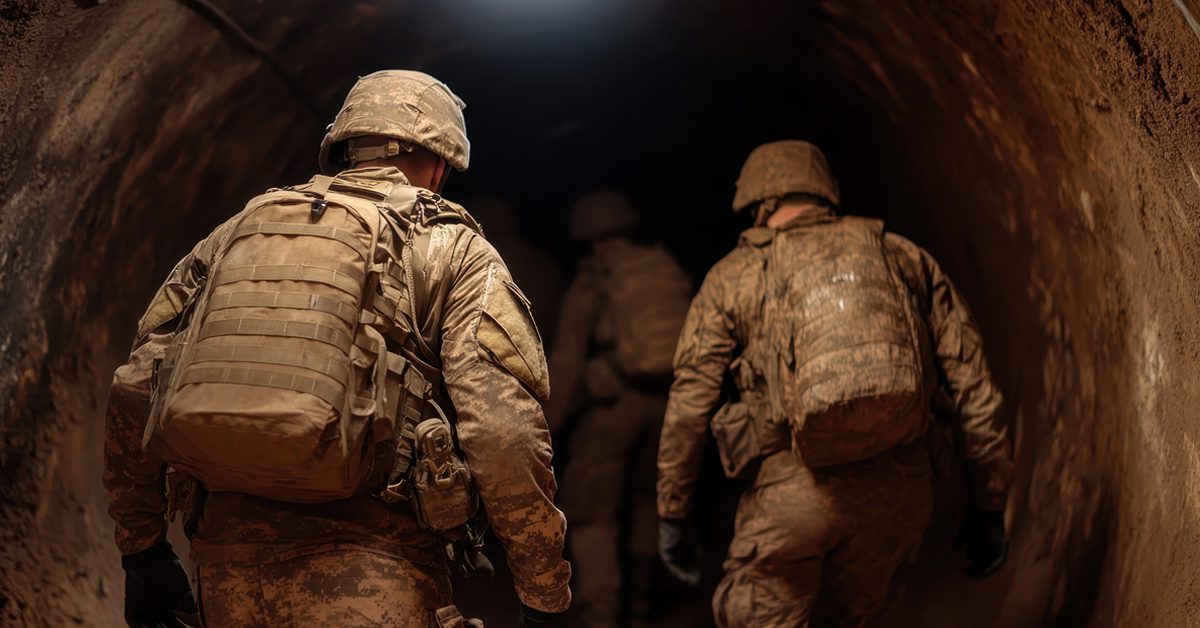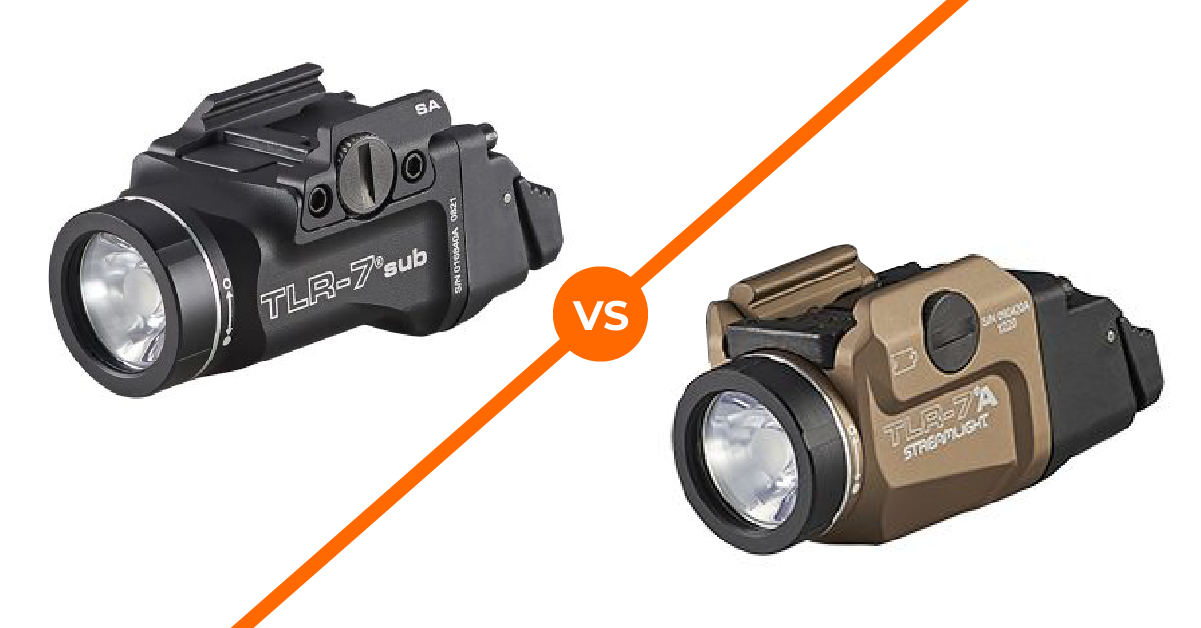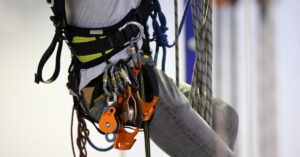When it comes to compact tactical weapon lights, the Streamlight TLR-7 and TLR-7A are two of the most popular options on the market. These ultra-compact gun lights pack impressive power into small, sleek designs, making them a go-to choice for both professionals and hobbyists who need reliable performance in critical moments.
While both models share many similarities, choosing the right one for your specific needs can be a bit confusing. Each offers unique features and benefits that cater to different preferences and tactical applications. Whether you’re considering the ergonomics of the rear switch or the overall handling of the light, it’s essential to understand what sets these two models apart.
In this guide, we’ll break down the key differences and similarities between the Streamlight TLR-7 and TLR-7A. We’ll compare their design, features, performance, and user feedback, so you can make an informed decision about which tactical light is best suited for your firearm and use case.
Overview of the Streamlight TLR-7 and TLR-7A
The Streamlight TLR-7 and TLR-7A are two highly regarded tactical weapon lights, designed to deliver powerful illumination in a compact and durable package. Whether you’re a law enforcement professional, a military operator, or a civilian firearm enthusiast, both models offer exceptional performance in low-light situations, making them an essential accessory for handguns.
Streamlight TLR-7

The Streamlight TLR-7 is engineered to provide high-output lighting while maintaining a minimal profile on your firearm. With a 500-lumen LED beam that reaches up to 140 meters, this model is perfect for situations that require both wide-area illumination and precise targeting. Its low-profile design ensures it won’t interfere with your holstering, and the ambidextrous side switch makes it easy to operate, whether you’re left- or right-handed. The TLR-7 is ideal for anyone looking for a reliable, no-frills tactical light for everyday carry or home defense.
Streamlight TLR-7A

The Streamlight TLR-7A is an upgraded version of the TLR-7, designed with ergonomics in mind. The most significant difference is the addition of a user-friendly rear switch option, which allows for easier activation without adjusting your grip. Like the TLR-7, it boasts a powerful 500-lumen output, but the switch customization makes it more comfortable for users who prioritize quick, intuitive controls during tactical operations. This model is particularly well-suited for those who need greater versatility in their weapon light, whether for self-defense, range use, or professional duty.
Both lights are designed for tactical applications where reliability, durability, and ease of use are critical. However, as we dive deeper into their features and differences, you’ll begin to see how each one caters to different user preferences and needs.
TLR-7 vs TLR 7A: Design and Ergonomics
When comparing the Streamlight TLR-7 and TLR-7A, one of the most significant distinctions lies in their design and ergonomics. While both models maintain the same compact form factor, subtle differences in size, weight, and usability can make a big impact on your overall experience.
Whether you prioritize ease of use, balance, or tactical performance, understanding these differences will help you decide which light fits your needs and firearm best.
Size and Weight
Both the TLR-7 and TLR-7A are designed to be lightweight and low-profile, ensuring they don’t add bulk or interfere with your firearm’s balance. The Streamlight TLR-7 weighs in at just 2.4 ounces, with a length of 2.15 inches. This compact size makes it ideal for concealed carry or duty weapons, as it won’t snag on holsters or impact your draw speed. Its small size also means it fits seamlessly on subcompact handguns.
The Streamlight TLR-7A is nearly identical in size and weight, maintaining the same ultra-compact design. However, its ergonomically enhanced rear switch slightly alters the handling feel. Both models are designed to preserve your firearm’s balance, and users will find that neither model adds unnecessary weight that could affect shooting accuracy or handling in high-pressure situations.
In terms of size and weight, the differences between these models are negligible, but it’s the next factors—ergonomics and switch configuration—that set them apart.
Switch Configuration and Usability
One of the most noticeable differences between the TLR-7 and TLR-7A is the switch design. The TLR-7 features an ambidextrous side switch, which requires users to press with their trigger finger or thumb, depending on the grip and hand dominance. While this switch placement is functional, some users may find it less intuitive in high-stress situations, as it can require adjusting your grip slightly to activate the light.
The TLR-7A, on the other hand, offers a significant upgrade with its rear switch options. This ergonomic improvement makes it much easier to activate the light without shifting your grip. Whether you prefer the high or low rear switch, both configurations are designed to accommodate your natural hand position. This difference makes the TLR-7A particularly appealing to those who need quick, reliable activation during tactical or self-defense situations. The switch’s intuitive design is especially beneficial in low-light conditions where reaction time is critical.
Mounting System
Both the TLR-7 and TLR-7A use Streamlight’s quick-attach rail clamp system, making installation on a wide range of firearms fast and easy. The mounting system is compatible with standard Picatinny and Glock-style rails, ensuring it fits securely on most handguns. This universal fit means you can easily move the light between different firearms without the need for specialized tools or mounts.
However, some users have reported that the TLR-7’s mounting system can be slightly stiffer compared to the TLR-7A, which Streamlight has fine-tuned to make the attachment process even smoother. Both models maintain excellent stability once mounted, and you won’t need to worry about the light shifting during recoil or under repeated use.
Overall, both lights offer secure, dependable mounting systems, but the TLR-7A’s adjustments to ease of attachment give it a slight edge for users who frequently switch firearms.
Performance Comparison between the TLR-7a and the TLR-7
When it comes to tactical applications, the performance of your weapon light is just as crucial as its design. Both the Streamlight TLR-7 and TLR-7A are designed to deliver reliable, high-output illumination when you need it most, but how do they stack up in real-world scenarios? In this section, we’ll break down the key performance differences between these two models, focusing on their light output, beam pattern, and battery life.
Light Output and Beam Pattern
At first glance, the Streamlight TLR-7 and TLR-7A appear nearly identical in terms of light output. Both models offer a maximum output of 500 lumens, which is more than enough for most tactical scenarios. This brightness level ensures that users have excellent visibility in low-light conditions, whether indoors or outdoors. The beam distance for both models reaches approximately 140 meters, allowing you to illuminate a broad area with ease.
However, the beam pattern is where these models slightly differ. The TLR-7 produces a concentrated beam with a well-defined hotspot, making it ideal for focused, long-distance illumination. This tight beam is especially useful when you need to direct light toward a specific target or area without flooding the surroundings.
The TLR-7A, while maintaining the same lumen output, offers a slightly wider beam pattern. This difference allows for better peripheral vision in close-quarter engagements, as the light spreads more evenly across the room or outdoor space. The broader beam can enhance situational awareness, making the TLR-7A a better choice for users who need a mix of both distance and floodlight capabilities in their tactical operations.
Battery Life and Power Management
Both the TLR-7 and TLR-7A are powered by a single CR123A lithium battery, which delivers solid battery life for a compact tactical light. On average, both models provide about 1.5 hours of continuous runtime at full brightness, which is standard for weapon lights in this category. This should be sufficient for most tactical engagements or home defense scenarios, but it’s always recommended to carry spare batteries if you anticipate extended use.
When it comes to power management, both models are equipped with features that help optimize battery efficiency. For instance, both the TLR-7 and TLR-7A utilize Streamlight’s optimized electronics, which help regulate power consumption to maintain consistent brightness throughout the battery life. This ensures that you won’t experience a sudden drop in brightness as the battery depletes, providing reliable illumination for the duration of the runtime.
However, frequent users report that the TLR-7A’s ergonomically improved switch design allows for more controlled usage, potentially preserving battery life during brief, intermittent activations. This may be a small but notable advantage for those who rely on their light for short bursts of use rather than extended periods of continuous operation.
In conclusion, both models perform admirably in terms of light output and battery life, but the TLR-7A’s wider beam pattern and more intuitive switch placement may give it a slight edge for users who prioritize quick, tactical engagements.
Features and Additional Functionalities
When choosing between the Streamlight TLR-7 and TLR-7A, additional features can be a crucial factor in your decision. While both models are built to provide high-performance lighting, they also offer a few extra functionalities that could make the difference, especially in tactical or high-stress situations. In this section, we’ll take a closer look at the unique features each model offers and how they enhance their tactical effectiveness.
Strobe Mode and Tactical Applications
Neither the Streamlight TLR-7 nor the TLR-7A comes with a built-in strobe mode. While some Streamlight models do include a strobe function for tactical disorientation, these compact models focus on delivering a steady, high-output beam.
While the lack of a strobe mode may disappoint some users, it’s important to note that the primary purpose of both the TLR-7 and TLR-7A is to provide straightforward, dependable illumination. Their consistent beam is ideal for target identification and precision in tactical situations, without the need for additional strobe effects. For most tactical applications, particularly self-defense or law enforcement, the steady beam provides ample visibility and focus.
However, for users specifically looking for a light that can disorient opponents or serve as an emergency signaling tool, you may need to look at other models in Streamlight’s lineup that include a strobe feature. Still, the simplicity of these models can be seen as a benefit, as it reduces the complexity of operation under stress.

Durability and Weather Resistance
Both the TLR-7 and TLR-7A are built with the same robust construction and feature the same durable materials. Each model is housed in anodized machined aluminum, making them lightweight yet tough enough to withstand harsh conditions and rough handling. These tactical lights are designed to handle the rigors of law enforcement, military use, or civilian self-defense.
In terms of weather resistance, both models are rated IPX7, which means they are waterproof up to 1 meter for 30 minutes. Whether you’re caught in the rain, navigating wet environments, or dealing with dust and debris, you can trust that both the TLR-7 and TLR-7A will keep performing without issue. Their dustproof construction adds an extra layer of protection, ensuring that dirt and grit won’t interfere with their operation.
This level of durability makes both lights suitable for outdoor use, whether you’re on the range or in a tactical situation. Additionally, the recessed switch and protected lens design on both models help prevent damage from accidental impacts or drops, further ensuring the longevity of the lights.
Overall, the TLR-7 and TLR-7A are equally durable and weather-resistant, making either a solid choice for users who need a light that can handle tough environments. Whether you’re looking for ruggedness in everyday carry or confidence in critical tactical moments, both lights deliver on durability.
Pricing and Value for Money
When deciding between the Streamlight TLR-7 and the Streamlight TLR-7A, pricing can be a key factor, especially for those who are budget-conscious but still want high-quality performance. Both models are priced competitively within the tactical light market, offering excellent value for the features they provide.
The TLR-7 is typically priced slightly lower than the TLR-7A, making it a more attractive option for buyers who are looking for a reliable, no-frills tactical light without the added cost of upgraded ergonomics. Its lower price point does not compromise on performance, as it still delivers powerful illumination and durable construction.
On the other hand, the TLR-7A comes with a modest price increase due to its enhanced rear switch design, which improves usability and ergonomics. This slight bump in price can be well worth it for those who prioritize ease of use, especially in high-pressure situations where quick activation is essential. For users who value comfort and intuitive controls, the extra cost of the TLR-7A can be justified by its more user-friendly design.
Ultimately, both models offer great value for money, but your decision may come down to whether you prefer the simplicity and affordability of the TLR-7 or the enhanced ergonomics of the TLR-7A.
Warranty and Customer Support
Streamlight offers solid warranty coverage and customer support for both the TLR-7 and TLR-7A, giving buyers peace of mind with their purchase. Both models come with Streamlight’s limited lifetime warranty, which covers defects in materials and workmanship. This means that if you encounter any issues with your light due to manufacturing problems, Streamlight will repair or replace the product as needed.
In addition to the warranty, Streamlight is known for its responsive customer service team, offering reliable support should you need assistance with your light. Whether it’s a question about installation, functionality, or warranty claims, Streamlight’s customer service is easy to reach and highly regarded in the industry.
The warranty and customer support offered by Streamlight are the same for both the TLR-7 and TLR-7A, so no matter which model you choose, you can rest assured that your investment is backed by a company known for standing behind its products. This level of support is particularly important for tactical gear, where reliability is key, and Streamlight delivers on that front.
User Reviews and Feedback
User reviews and feedback are often some of the most valuable tools when deciding between two similar products. Both the Streamlight TLR-7 and TLR-7A have garnered significant attention in the tactical light community, and understanding how these lights perform in real-world applications can help prospective buyers make informed decisions. In this section, we’ll summarize common praises and complaints, as well as highlight the best applications for each model based on user experiences.
Common Praises and Complaints
When looking at user reviews for both the TLR-7 and TLR-7A, several common themes emerge in terms of both positive feedback and areas of criticism.
Praises
- Compact Design: Users consistently appreciate the compact and lightweight design of both models, noting that they do not interfere with holstering or balance when mounted on a firearm. This is particularly praised by those who carry their weapons daily, whether for personal defense or in professional settings.
- Bright Light Output: The 500-lumen output is a major selling point for both the TLR-7 and TLR-7A. Users frequently commend the brightness and beam distance, emphasizing that these lights provide more than enough illumination for close-to-medium range scenarios, even in pitch-dark environments.
- Durability: Both models are praised for their rugged construction and weatherproof capabilities, with users noting that the lights withstand rough handling and exposure to rain or moisture without any issues.
Complaints
- Switch Placement on the TLR-7: A common complaint about the TLR-7 is the placement of the side switch, which some users find awkward or difficult to reach without slightly adjusting their grip. This has led some users to opt for the TLR-7A for its improved rear switch ergonomics.
- No Strobe Feature: Some users have expressed disappointment that neither model includes a strobe mode, a feature commonly found in other tactical lights. For those looking for an option that offers a disorienting strobe function, this is seen as a drawback.
- Price: While generally viewed as offering good value, some budget-conscious users note that the price of the TLR-7A, in particular, can be slightly high compared to similar lights on the market, especially for those who don’t need the ergonomic upgrades.
Best Applications Based on Feedback
Based on user feedback, it’s clear that both the TLR-7 and TLR-7A excel in different tactical applications, making them suitable for various user groups.
- Home Defense: For home defense applications, the TLR-7A often comes out on top, particularly because of its ergonomic rear switch. Users who rely on their weapon lights for quick response in stressful situations appreciate the easy access to the rear switch, allowing them to activate the light without losing their shooting grip. The wider beam pattern of the TLR-7A is also preferred for illuminating larger spaces like rooms and hallways.
- Law Enforcement and Professional Use: The TLR-7 and TLR-7A both receive high marks from law enforcement professionals, but the TLR-7’s more focused beam pattern is often appreciated by officers needing targeted illumination at a distance. The compact design also makes both models ideal for mounting on duty weapons, ensuring they don’t add unnecessary bulk during patrols or in the field.
- Everyday Carry (EDC): For civilians who carry daily, both lights are considered excellent options, but the TLR-7’s slightly lower price point makes it a more popular choice. The minimal design and reliable performance offer peace of mind without the extra cost, making it a practical choice for those who prioritize affordability alongside functionality.
In conclusion, user feedback highlights that both models perform well in a variety of tactical situations, but the specific needs of the user—whether ergonomic design, cost, or application—will ultimately guide which model is the better fit.
Which Should You Choose: Streamlight TLR-7 or TLR-7A?
When deciding between the Streamlight TLR-7 and the Streamlight TLR-7A, it ultimately comes down to your specific needs and preferences. Both models are compact, durable, and offer exceptional performance with their powerful 500-lumen output, making either option a reliable choice for tactical applications.
Key Differences
- Switch Design: The TLR-7 features a side switch, while the TLR-7A introduces a more ergonomic rear switch, making it easier to activate without adjusting your grip. If quick activation and comfort are high priorities, the TLR-7A is likely the better option for you.
- Beam Pattern: The TLR-7 has a more focused beam, ideal for targeting specific areas at longer distances, whereas the TLR-7A offers a slightly wider beam for enhanced peripheral visibility, making it more versatile for close-quarters and home defense scenarios.
- Price: The TLR-7A is slightly more expensive than the TLR-7, due to its ergonomic enhancements. If you’re looking for a more budget-friendly option that still delivers solid performance, the TLR-7 may be the better fit.
Which One Should You Choose?
- If you’re a law enforcement officer, military professional, or someone who values quick and comfortable activation, the TLR-7A’s rear switch design and wider beam make it an excellent choice for your tactical needs.
- On the other hand, if you’re looking for a no-nonsense, high-performing tactical light at a slightly lower price point, the TLR-7 offers great value and reliability, especially for everyday carry or precise target illumination.
Ultimately, both lights are highly rated and deliver what you need in a tactical light. The best choice depends on whether you prioritize enhanced ergonomics or are seeking a more straightforward, affordable option.




